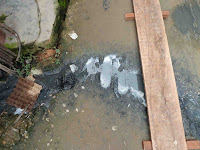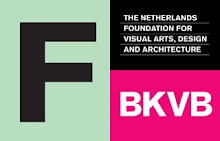By Berend van der Lans,
Architecture plus
La Nouvelle Liberté by Joseph-Francis Sumégné, 2007
Doual’art plays an exceptional role in the city of Douala, by initiating and stimulating urban interventions by artists and public artwork at several locations at a variety of scales in the city. The non-governmental organization, headed by Princess Marilyn Douala-Bell, Didier Schaub and Paulin Tchuenbou, has influenced the image of Douala through their projects undertaken in the last two decades.
Since 2007, the activities and events undertaken by the organization are knitted together through triennial events. The second ‘Salon Urbaine de Douala’ (SUD2010), took place between 4 and 11 December 2010 and was related to the theme of Douala’s somehow troubled relationship with water.
The origin of the city of Douala is formed by a group of small settlements on the banks of the Wouri estuary, populated with fishermen. The Douala culture is hence strongly related to water, both in myths and customs.
Since the German settlers colonised Cameroon, the areas on the banks of the river were reserved for Europeans and later were fully used for harbour activities. For the people of Douala, direct access to the Wouri was nearly fully cut off, the city now seems to be positioned with its back turned to the river.
 The harbour zone is blocking any contact between the city and the Wouri estuary
The harbour zone is blocking any contact between the city and the Wouri estuary
(image: Mauro Alessandro Lugaresi)
Douala is known as one of the places in the world with the highest amount of annual rain fall. The unplanned sprawl of the city has been frustrating the natural flow of the abundant seasonal streams of water, creating numerous problems in the densely inhabited city. Yearly floods result in destroyed housing, damaged private and public asset and in serious health threads to Douala’s inhabitants. Nonetheless, the abundant availability of water also creates chances.
In 2011 construction works start of a new deepwater port in Kribi. The idea is to shift part of the harbour activities of Douala to Kribi and Limbe, another town close to the ocean. In this way the continuous deepening of the Wouri to Douala for deepwater vessels can be avoided.
This results in challenges as well as threads for the largest and economically most active city of Cameroon. The banks of the Wouri will become accessible for the people of Douala once again, hopefully in such a way that the relationship between the Wouri and the Douala inhabitants is not only present in myths and the yearly Ngondo ceremony, but on a more firm basis.
On the other hand, the harbour offers a great direct and indirect economic driver for a large majority of the population of the Douala region. The shift of harbour activities will threaten the income positions of many families and stimulate them to follow the harbour bound companies. It remains to be seen, what impact this will have on the city. It seems obvious that any new plan for the gained harbour banks should include new economic developments to avoid an increase of poverty in the region.
While above and more issues were discussed during ‘conferences’ at the Doual’art premises, SUD2010 also offered presentations of many artworks, vernissages and performances at other locations in the city.
Performance by Regina Geoger along the banks of the Wouri river,
attracting many harbor workers
Some of the work which was presented clearly developed a dialogue with the people of Douala, either at large or within specific areas.
At Bonamouti two projects were developed. Le jardin sonore by Lucas Grandin offers a vertical garden where the people of the neighbourhood can retreat and enjoy the sounds created by water drops dripping off the structure. Salifou Lindou, a painter and sculptor living in Bonamouti, created Face à l’Eau, an installation of five panels, offering privacy at a bathing site on the banks of the Wouri for the men of the area.
Top: Le jardin sonore by Lucas Grandin at Bonamouti
Bottom: Face à l’Eau by Salifou Lindou
(photos from www.doualart.org)
In New Bell, another neighbourhood of the city, one of the oldest areas and with a high density, several artists created food for thought for the inhabitants. Hervé Yamguen developed Les Mots Écrits, a poetic approach for his home neighbourhood by involving 5 rappers into creating songs, of which certain lines were executed as wall sculptures at several spots of the area. The rap songs were performed during SUD2010 and recorded onto the CD Wash mes ways (to be downloaded via the
SUD2010 website). Kamiel Verschuren explored a pragmatic approach with New Walk Ways New Bell, by developing timber covers for the open sewers of New Bell, once covered by concrete slabs but since long open. The execution of these covers, only at specific locations, created discussions amongst the inhabitants, that it would be good to also develop covers for the parts which are still open and continue to collect dirt and rubbish, thus blocking the stream and resulting in flooded streets with contaminated water.
Hervé Yamguen explaining one of the wall sculptures of Les Mots Écrits in New Bell
New Walk Ways New Bell by Kamiel Verschuren
The Dutch artist Ties ten Bosch settled for 2 months in Ndogpassi, a more recently developed neighbourhood. Many people living in this area did migrate from villages upcountry. The settlements have a more informal feel but by lack of authority are toughly managed by a chef and a committee of men. Via this communal organisational system, decisions on maintenance of public services are made, but also financial assistance for inhabitants who are in need for some help. Diving in deep by Ties Ten Bosch is rather a story than an art work in situ; he documented his stay in the area via video, bottles of water and images. Meanwhile he challenged his temporary neighbours in developing projects with sometimes smaller, sometimes as larger impact on the liveability of the area. While in full contact with the chef and the committee, he developed street names and signs for the main arteries of the neighbourhood. Daily water samples were showcased as a diary of the stream through the area. The force majeure was the construction of a bridge between Ndogpassi and the neighbouring area on the other side of the stream. Shortly after SUD2010 Ten Bosch returned home. The impact of his work remains to be seen, but the bridge is sturdy enough to survive many years of neglect.

The water bottle diary as part of Diving in deep by Ties ten Bosch in Ndogpassi
In the same area, at a beautiful location around and above a local source forming the heart of Ndogpassi, Philip Aguirre developed Source. The project, basically an amphitheatre following the existing shapes of the landscape, will be executed in 2011, but was presented to the chef, the committee and the neighbourhood with a celebrative ceremony during SUD2010. This ceremony proved that the location forms an excellent stage for similar events.
The presentation of Source by Philip Aguirre at Ndogpassi
Individually the impact of the above and other projects developed under the umbrella of Doual’art are minimal and it remains to be seen if these projects really do result in creating awareness of the people of Douala. On the other hand, taking into account the involvement of the people and the reaction on the projects, the positive, aesthetic but hands-on approach does work catching. It makes it useful to return to Douala on a regular basis. It is to be hoped that many Salons Urbains de Douala will follow.
SUD2010 is organised by Doual’art and supported by ICU art projects.
More info on
www.doualart.org.
Underneath, you will find some more images taken by Berend van der Lans during SUD2010.
 All well dressed and well registered during the Ngondo ceremony
All well dressed and well registered during the Ngondo ceremony
 Doual’art premises
Doual’art premises
Arrival of palm trunk for palm wine production, part of the full recycling program by 2012 Architects
Ties ten Bosch explains Diving in Deep in Ndogpassi
Intermezzo during the presentation of Source by Philip Aguire
Pont Source by Ties ten Bosch in Ndogpassi
La Colonne Pascale by Pascale Marthine Tayou (bottom left) at a mayor junction in New Bell
Vernissages with work from Boris Nzebo (top) and Alioum Moussa (bottom)






























































